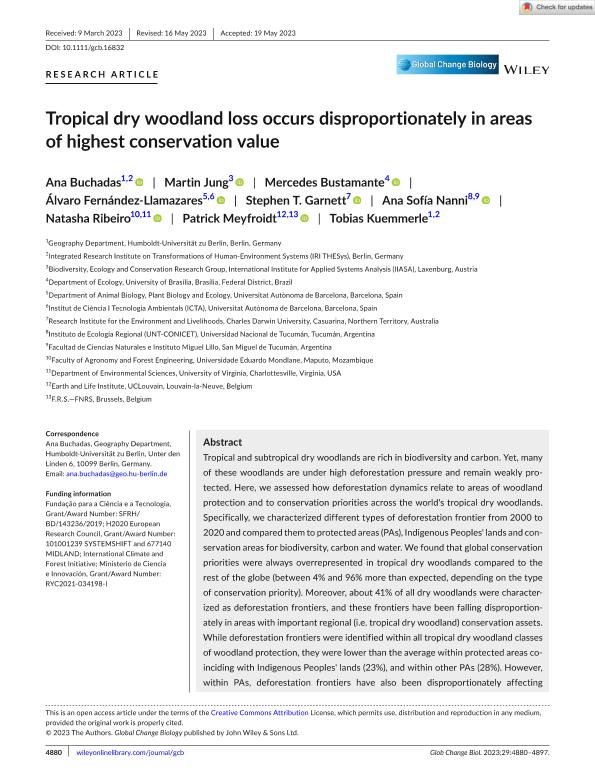Mostrar el registro sencillo del ítem
dc.contributor.author
Buchadas, Ana
dc.contributor.author
Jung, Martin
dc.contributor.author
Bustamante, Mercedes
dc.contributor.author
Fernández Llamazares, Álvaro
dc.contributor.author
Garnett, Stephen T.
dc.contributor.author
Nanni, Ana Sofía

dc.contributor.author
Ribeiro, Natasha
dc.contributor.author
Meyfroidt, Patrick

dc.contributor.author
Kuemmerle, Tobias

dc.date.available
2024-04-16T12:06:46Z
dc.date.issued
2023-09
dc.identifier.citation
Buchadas, Ana; Jung, Martin; Bustamante, Mercedes; Fernández Llamazares, Álvaro; Garnett, Stephen T.; et al.; Tropical dry woodland loss occurs disproportionately in areas of highest conservation value; Wiley Blackwell Publishing, Inc; Global Change Biology; 29; 17; 9-2023; 4880-4897
dc.identifier.issn
1365-2486
dc.identifier.uri
http://hdl.handle.net/11336/233144
dc.description.abstract
Tropical and subtropical dry woodlands are rich in biodiversity and carbon. Yet, many of these woodlands are under high deforestation pressure and remain weakly protected. Here, we assessed how deforestation dynamics relate to areas of woodland protection and to conservation priorities across the world´s tropical dry woodlands. Specifically, we characterized different types of deforestation frontier from 2000 to 2020 and compared them to protected areas (PAs), Indigenous Peoples´ lands and conservation areas for biodiversity, carbon and water. We found that global conservation priorities were always overrepresented in tropical dry woodlands compared to the rest of the globe (between 4% and 96% more than expected, depending on the type of conservation priority). Moreover, about 41% of all dry woodlands were characterized as deforestation frontiers, and these frontiers have been falling disproportionately in areas with important regional (i.e. tropical dry woodland) conservation assets. While deforestation frontiers were identified within all tropical dry woodland classes of woodland protection, they were lower than the average within protected areas coinciding with Indigenous Peoples´ lands (23%), and within other PAs (28%). However, within PAs, deforestation frontiers have also been disproportionately affecting regional conservation assets. Many emerging deforestation frontiers were identified outside but close to PAs, highlighting a growing threat that the conserved areas of dry woodland will become isolated. Understanding how deforestation frontiers coincide with major types of current woodland protection can help target context-specific conservation policies and interventions to tropical dry woodland conservation assets (e.g. PAs in which deforestation is rampant require stronger enforcement, inactive deforestation frontiers could benefit from restoration). Our analyses also identify recurring patterns that can be used to test the transferability of governance approaches and promote learning across social–ecological contexts.
dc.format
application/pdf
dc.language.iso
eng
dc.publisher
Wiley Blackwell Publishing, Inc

dc.rights
info:eu-repo/semantics/openAccess
dc.rights.uri
https://creativecommons.org/licenses/by/2.5/ar/
dc.subject
AREA-BASED CONSERVATION
dc.subject
CONSERVATION PRIORITIES
dc.subject
DEFORESTATION
dc.subject
PROTECTED AREAS
dc.subject
TROPICAL AND SUBTROPICAL DRY FORESTS AND SAVANNAS
dc.subject.classification
Ciencias Medioambientales

dc.subject.classification
Ciencias de la Tierra y relacionadas con el Medio Ambiente

dc.subject.classification
CIENCIAS NATURALES Y EXACTAS

dc.title
Tropical dry woodland loss occurs disproportionately in areas of highest conservation value
dc.type
info:eu-repo/semantics/article
dc.type
info:ar-repo/semantics/artículo
dc.type
info:eu-repo/semantics/publishedVersion
dc.date.updated
2024-04-12T13:13:29Z
dc.journal.volume
29
dc.journal.number
17
dc.journal.pagination
4880-4897
dc.journal.pais
Reino Unido

dc.description.fil
Fil: Buchadas, Ana. Humboldt-Universität zu Berlin; Alemania
dc.description.fil
Fil: Jung, Martin. International Institute For Applied Systems Analysis; Austria
dc.description.fil
Fil: Bustamante, Mercedes. Universidade do Brasília; Brasil
dc.description.fil
Fil: Fernández Llamazares, Álvaro. Universitat Autònoma de Barcelona; España
dc.description.fil
Fil: Garnett, Stephen T.. Charles Darwin University. School of Environmental Research; Australia
dc.description.fil
Fil: Nanni, Ana Sofía. Universidad Nacional de Tucumán. Instituto de Ecología Regional. Consejo Nacional de Investigaciones Científicas y Técnicas. Centro Científico Tecnológico Conicet - Tucumán. Instituto de Ecología Regional; Argentina
dc.description.fil
Fil: Ribeiro, Natasha. University of Virginia; Estados Unidos
dc.description.fil
Fil: Meyfroidt, Patrick. Université Catholique de Louvain; Bélgica
dc.description.fil
Fil: Kuemmerle, Tobias. Humboldt-Universität zu Berlin; Alemania
dc.journal.title
Global Change Biology

dc.relation.alternativeid
info:eu-repo/semantics/altIdentifier/doi/http://dx.doi.org/10.1111/gcb.16832
Archivos asociados
